Papers by Christina Kapadocha
VOZ e CENA, 2024
This article advances the author’s concept of somatic logos as an inter-embodied praxical framewo... more This article advances the author’s concept of somatic logos as an inter-embodied praxical framework that facilitates interrelations between individual and collective voices. It draws from her Practice-as-Research (PaR) project From Haptic Deprivation to Haptic Possibilities and uses the project’s Are We Still in Touch? group workshops as a case study. The workshops investigate how self-directed touch (initiated and managed by oneself) can support one’s sense of care, wellbeing, and creative expression amidst societal shifts catalyzed by the pandemic. Research findings suggest that somatic listening to the self extends to an inter-embodied sense of care with potentials for broader societal impact.

Theatre, Dance and Performance Training
This article draws from the practice-research project under the umbrella title ‘From Haptic Depri... more This article draws from the practice-research project under the umbrella title ‘From Haptic Deprivation to Haptic Possibilities’. The project began as a response to the first COVID-19 lockdown in the UK in March 2020 and the necessary transition to online interactions. As a practitioner-researcher who has been critically investigating tactile possibilities through somatically inspired methods within and outside actor training, I identified a ‘gap’ in how we could still embody relational potentialities of touch either working remotely or while practising physical distancing. Modified physical contact in my practice research originates in my work with actors in training and widens in online sessions and in-person workshops with non-actors. This article focuses on tactile renegotiations in actor training and critical observations regarding what touch can be, challenging universal and unified perceptions. Advancing two published TDPT blog posts on the project, the discussion directs attention to how necessary physical distantiation during the pandemic expanded the use of touch in my training practice and how these tactile renegotiations can be applied post-pandemically within and beyond actor training. Inspired by phenomenological and feminist theories of embodiment, touch is proposed as an ethical renegotiation between self and other that necessitates differentiation and distantiation in nearness.
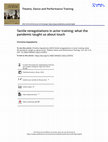
Theatre, Dance and Performance Training, 2023
This article draws from the practice-research project under the umbrella title ‘From Haptic Depri... more This article draws from the practice-research project under the umbrella title ‘From Haptic Deprivation to Haptic Possibilities’. The project began as a response to the first COVID-19 lockdown in the UK in March 2020 and the necessary transition to online interactions. As a practitioner-researcher who has been critically investigating tactile possibilities through somatically inspired methods within and outside actor training, I identified a ‘gap’ in how we could still embody relational potentialities of touch either working remotely or while practising physical distancing. Modified physical contact in my practice research originates in my work with actors in training and widens in online sessions and in-person workshops with non-actors. This article focuses on tactile renegotiations in actor training and critical observations regarding what touch can be, challenging universal and unified perceptions. Advancing two published TDPT blog posts on the project, the discussion directs attention to how necessary physical distantiation during the pandemic expanded the use of touch in my training practice and how these tactile renegotiations can be applied post-pandemically within and beyond actor training. Inspired by phenomenological and feminist theories of embodiment, touch is proposed as an ethical renegotiation between self and other that necessitates differentiation and distantiation in nearness.
my somatic voice is. Concept by Christina Kapadocha. Co-designed with Vivianna Chiotini. © Christ... more my somatic voice is. Concept by Christina Kapadocha. Co-designed with Vivianna Chiotini. © Christina Kapadocha. Christina Kapadocha (PhD) is a Lecturer in Theatre and Movement at East 15 Acting School. She is a London-based theatre and somatic practitioner-researcher and founder of Somatic Acting Process®. Her current practice research and publications introduce new discussions on the somatic in theatre and performance studies.

Journal of Dance & Somatic Practices, 2017
This article introduces a new Body-Mind Centering (BMC®)/Integrative Bodywork and Movement Therap... more This article introduces a new Body-Mind Centering (BMC®)/Integrative Bodywork and Movement Therapy (IBMT)-inspired somatic acting and creative methodology as part of my Somatic Acting Process® (SAP®) practice. It briefly unpacks the journey and the current shape of this ongoing actor-training pedagogy, along with my growing development as a somatically aware actor-trainer and educator. The discussion situates my practice within a lineage of somatic-based processes in conservatoire actor training, suggesting further developments through the modification of Bonnie Bainbridge Cohen’s somatic process of embodiment and practices of witnessing in my current teaching. This article is necessarily a very concise sample of a larger and continuously developing praxis. Nevertheless, it proposes the valuable contribution of a somatically-informed creative practice for the understanding and communication of acting as innately interrelational and at the same time uniquely individual experience, as a process of dynamic sensitivity and responsibility.
Theatre, Dance and Performance Training, 2018
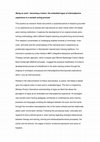
Being an actor / becoming a trainer: the embodied logos of intersubjective experience in a somati... more Being an actor / becoming a trainer: the embodied logos of intersubjective experience in a somatic acting process This practice-as-research thesis documents a sustained period of research grounded in my experience as an actress who has become an actor-trainer within UK-based actor-training institutions. It explores the development of an original somatic actor-training methodology within different theatre teaching and performing environments. This research concentrates on challenging dualistic binaries of mind-body, inner-outer, self-other and the universalizing of the individual actor’s experience as problematic logocentrism in Stanislavski-inspired actor-training traditions. It is informed in practice by Linda Hartley’s IBMT (Integrative Bodywork and Movement Therapy) somatic approach, which is based upon Bonnie Bainbridge Cohen’s Body-Mind Centering® (BMC®) principles. I suggest the practical modification of Cohen’s developmental process of embodiment in the actor-training context...

Taking as a point of departure the ongoing and ever-evolving interaction between theatre arts and... more Taking as a point of departure the ongoing and ever-evolving interaction between theatre arts and communities, this article expands upon ideas on bodies and communities bringing together somatic, theatre and community studies. It uses as a case study a somatically inspired theatre praxis gathering that took place in the village of Kato Garouna (Corfu, Greece) during summer 2018 (23‐26 August). The gathering is identified as a ‘community-conscious’ project, which led to the awareness of ‘community as soma’. This approach to community inquiry, supported by the openness of somatic and practice-research methodologies, allows the integration of embodied differences and dualities within creative co-presence. It also prompts the emergence of new interactive possibilities between newly shaped and existing groups through critical and ethical attention to invitations. Reflecting upon the methods that underlined the gathering process, communities are examined in relation to the invitations tha...
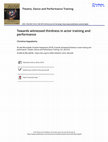
This article discusses the importance of understanding immersive, interactive and participatory p... more This article discusses the importance of understanding immersive, interactive and participatory performances as environments of potential witnessed thirdness between actors and spectators. It draws on the dynamic interconnection between my teaching experience as somatic movement educator at East 15 Acting School in London and my practice research on the modification of somatic practices into contemporary actor-training and performance contexts. Situating my practice in the lineage of modern somatically informed and embodied actor-training pedagogies, the article outlines how we can revisit actor‒spectator intercorporeal dynamics based upon principles of witnessing in the practice of Authentic Movement and Jessica Benjamin’s concept of thirdness. The last part of this article considers practical examples in relation to the discussed witnessed thirdness, integrating my classroom experience with material from my recent piece Monotime (Performing Architectures, Ugly Duck, London, 18‒19 June 2016). The discussion ultimately suggests a methodological expansion of intercorporeal actor-training practices through the acknowledged third co-presence between diverse actor-witnesses and spectator-witnesses.
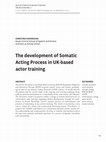
This article introduces a new Body-Mind Centering (BMC®)/Integrative Bodywork and Movement Therap... more This article introduces a new Body-Mind Centering (BMC®)/Integrative Bodywork and Movement Therapy (IBMT)-inspired somatic acting and creative methodology as part of my Somatic Acting Process® (SAP®) practice. It briefly unpacks the journey and the current shape of this ongoing actor-training pedagogy, along with my growing development as a somatically aware actor-trainer and educator. The discussion situates my practice within a lineage of somatic-based processes in conservatoire actor training, suggesting further developments through the modification of Bonnie Bainbridge Cohen’s somatic process of embodiment and practices of witnessing in my current teaching. This article is necessarily a very concise sample of a larger and continuously developing praxis. Nevertheless, it proposes the valuable contribution of a somatically-informed creative practice for the understanding and communication of acting as innately interrelational and at the same time uniquely individual experience, as a process of dynamic sensitivity
and responsibility.
Conference Presentations by Christina Kapadocha
This is the programme of a two-day praxical symposium that took place at East 15 Acting School, L... more This is the programme of a two-day praxical symposium that took place at East 15 Acting School, London (19-20 July 2019). It was the culminating event of a wider research project, the main outcome of which will be a volume for Routledge Voice Studies Series (2020). The gathering was developed upon activities offered by the majority of the contributors to the project, a group of world-leading pioneers in teaching, researching and disseminating the significance of somatic or somatically-inspired practices towards new research methodologies in somatic and voice studies.
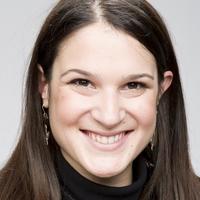
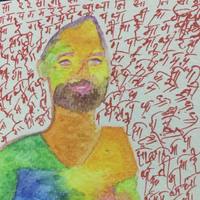
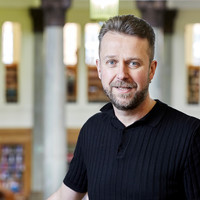

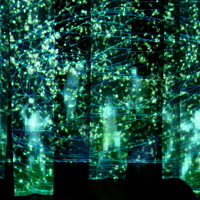
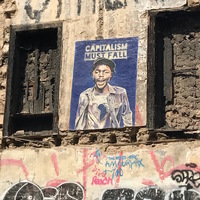
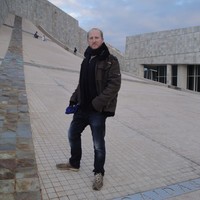

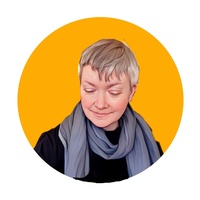
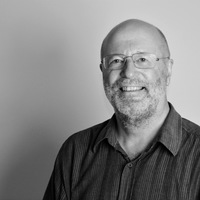
Uploads
Papers by Christina Kapadocha
and responsibility.
Conference Presentations by Christina Kapadocha
and responsibility.
Methodologies that can be found in this collection draw on:
eastern traditions
body psychotherapy-somatic psychology
Alexander Technique, Feldenkrais Method
Authentic Movement, Body-Mind Centering, Continuum Movement, Integrative Bodywork and Movement Therapy
Fitzmaurice Voicework, Linklater Technique, Roy Hart Method
post-Stanislavski and post-Grotowski actor-training traditions
somaesthetics
The volume also includes contributions by the founders of:
Shin Somatics, Body and Earth, Voice Movement Integration
SOMart, Somatic Acting Process
This book is a polyphonic and multimodal compilation of experiential invitations to each reader’s own somatic voice. It culminates with the "voices" of contributing participants to a praxical symposium at East 15 Acting School in London (July 19–20, 2019). It fills a significant gap for scholars in the fields of voice studies, theatre studies, somatic studies, artistic research and pedagogy. It is also a vital read for graduate students, doctoral and postdoctoral researchers.